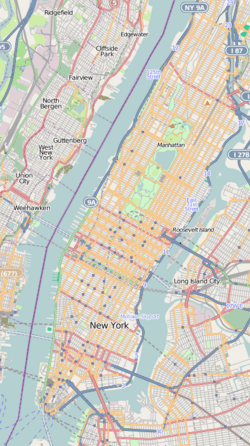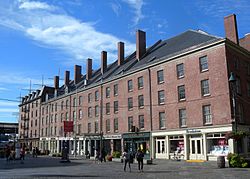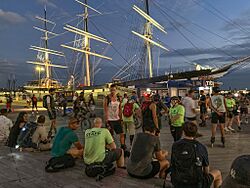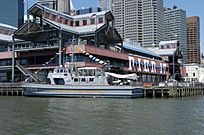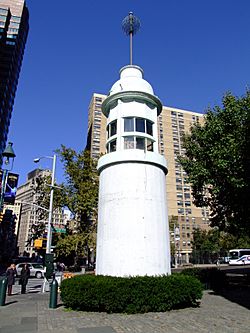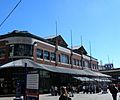South Street Seaport facts for kids
|
South Street Seaport
|
|
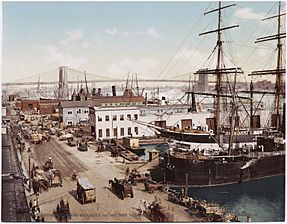
South Street and Brooklyn Bridge (c. 1900)
|
|
| Location | Bounded by Burling (John St.) and Peck Slips, Water St. and East River in New York City, United States |
|---|---|
| Area | 3.5 acres (1.4 ha) |
| Architect | multiple |
| Architectural style | Greek Revival |
| NRHP reference No. | 72000883 |
|
South Street Seaport Historic District
|
|
| Location | Roughly bounded by East River, Brooklyn Bridge, Fletcher Alley, and Pearl and South Streets, Manhattan, New York City, United States |
| Area | 41 acres (17 ha) |
| Architectural style | Greek Revival, Romanesque |
| NRHP reference No. | 78001884 |
Quick facts for kids Significant dates |
|
| Added to NRHP | December 12, 1978 |
| Added to NRHP | October 18, 1972 |
The South Street Seaport is a special historical area in New York City. It's located in Manhattan, right where Fulton Street meets the East River. This area is part of the Financial District in Lower Manhattan.
The Seaport is known as a historic district. It has some of the oldest buildings in Lower Manhattan. You can find many restored buildings from the early 1800s here. These include old shops, renovated sailing ships, and the former Fulton Fish Market. Today, it's also a popular spot for tourists with food, shopping, and fun nightlife.
Contents
History of the Seaport
Early Days of the Port
How the Seaport Started
The first pier in this area was built in 1625. This was when the Dutch West India Company set up a trading post. More settlers arrived, and the area quickly grew.
One of the first and busiest streets was Pearl Street. It was named after the pearl shells found on the coast. Because of its great location, Pearl Street became very popular with traders. Over time, the East River was made narrower. The pier was extended to Water Street, then to Front Street, and by the early 1800s, to South Street. This pier was well-liked because it was safe from strong winds and ice.
Trade and Revolution
In 1728, the Schermerhorn family started trading with Charleston, South Carolina. They brought goods like rice and indigo to New York. The port also received many goods from England.
During the American Revolutionary War in 1776, the British took control of the port. This hurt trade for eight years. After the war in 1783, many traders left, and businesses struggled. But the port quickly bounced back. From 1797 to the mid-1800s, New York had the biggest sea trade system in the country. From 1815 to 1860, it was known as the Port of New York.
A ship called the Empress of China sailed from the port on February 22, 1784. It went to Guangzhou and returned in 1785. It brought back green and black teas, porcelain, and other items. This trip started trade between the new United States and China.
Growth in the 1800s
On January 5, 1818, the ship James Monroe sailed from Liverpool. This started the first regular trips across the Atlantic Ocean, known as the Black Ball Line. These trips continued until 1878. Many other shipping companies started because this route was so successful. This shipping boom helped New York become a major world trade center.
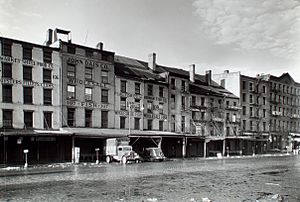
The Fulton Fish Market opened in 1822 and became one of the biggest businesses in the Seaport. The Tin Building, which opened in 1907, is one of the last original market buildings. In 2005, the market moved to Hunts Point, Bronx.
In November 1825, the Erie Canal opened. This canal connected New York to the western United States. It helped the city's economy grow a lot. Because of this, and the start of the shipping era, piers needed to be longer and the port deeper.
A huge fire in New York City on December 17, 1835, destroyed many buildings. The South Street Seaport was badly hit. But by the 1840s, the port had recovered. By 1850, it was at its busiest time.
The first Fulton Market burned down in 1878. A new red-brick Victorian building replaced it four years later.
Changes in the Late 1800s and Mid-1900s
At its busiest, the port had many businesses. These included shops, workshops, and places for sailors to stay. However, by the 1880s, the port started to decline. There wasn't enough space for new businesses. Also, the port became too shallow for newer, larger ships.
By the 1930s, most of the piers were no longer used. Cargo ships mainly docked on the West Side of Manhattan or in Hoboken. The second Fulton Market was torn down in 1951. A simpler building took its place. By the 1960s, many of the old docks were empty.
Bringing the Seaport Back to Life
Creating the Seaport Museum
In 1966, Peter Stanford and his wife Norma started the Friends of South Street. The next year, Peter began working to create a museum. This museum would be around South and Fulton streets. It was planned to include a ship docked at Pier 16 and buildings in a three-block area. The New York State Legislature had already allowed a museum on Schermerhorn Row.
The new South Street Seaport Museum met in June 1967. City officials thought the plan was difficult because it needed many approvals. The Titanic Memorial was given to the museum in 1968.
Meanwhile, museum supporters bought properties near Schermerhorn Row. By 1968, they found that developers were buying land to tear down buildings. The museum also started getting ships. They acquired the Lightship Ambrose, the schooner Caviar, and the ship Wavertree.
By 1969, the museum planned to spend $20 million on restoration. It covered about 8.5 acres. The museum owned four ships and had a small exhibit space. Restoration of the first building began on May 15, 1969. The museum's sponsors bought two blocks of Schermerhorn Row that July.
By the early 1970s, the Seaport Museum had an exhibit hall, a bookstore, and six ships. It hosted cultural events like sea shanty songs. The museum had half a million visitors each year. In March 1972, officials announced the Seaport would expand to 33 acres. This was part of a big development plan. However, this larger project stalled by 1975.
The city bought four blocks of the Seaport area in July 1973. The museum continued to run these sites. This allowed the city to sell air rights to a nearby company. In October, the museum announced plans to renovate three blocks. Peter Stanford left the museum in 1976. The museum then looked for a business partner to help redevelop the Seaport. In December 1977, the museum and the Rouse Company agreed to study redevelopment plans.
New Shops and Buildings in the 1980s
In September 1979, the Rouse Company and city groups agreed on a plan to redevelop the Seaport. This project was similar to successful projects in Baltimore and Boston. In June 1980, the city approved asking for a $28 million federal grant. The plan was approved in November, despite some worries about rising rents. It was expected to cost about $200 million and create many jobs. The plan included a large commercial building and a new Fulton Market building.
Some local business owners worried about being forced out by higher rents. But city officials said the project would help New Yorkers reconnect with the waterfront. Developers started turning two Seaport buildings into homes in 1981. The project received final approval that October. By then, the Seaport Museum had spent $9 million on ship restoration.
The first part of the Seaport redevelopment finished on July 28, 1983. It covered four blocks of the historic district. This included building the fourth Fulton Market, a three-story building with many shops. It also involved renovating 14 museum buildings and 12 buildings in Schermerhorn Row. This first phase quickly brought more business to the area. The second phase included a new structure on Pier 17. The Pier 17 mall opened on September 11, 1985. It had offices and a three-story shopping area.
Changes in the Late 1980s and 1990s
After Pier 17 opened, it didn't have many visitors at first. But by early 1986, it was almost full. The city also spent money to fix Pier 15 for ferry service. By the late 1980s, a poll found that the South Street Seaport was a favorite tourist spot for New Yorkers. However, visitor numbers were still lower than expected.
In 1993, the Seaport Museum gave the Fulton Market back to the city. It was hard to collect rent. Many market tenants had to leave. The Tin Building was badly damaged in a fire in 1995. By the late 1990s, the Fulton Market building was mostly empty. Most small shops on Pier 17 were replaced by larger chain stores.
The Seaport in the 2000s and Beyond
Early 2000s Changes
After several tries to redevelop 250 Water Street, the local community board voted in 2002. They wanted to limit new, large buildings in the Seaport. The South Street Seaport Museum also built its first permanent exhibit space. This was part of a $21 million renovation of Schermerhorn Row.
In 2004, General Growth Properties (GGP) bought the Rouse Company, which owned the Seaport. The Fulton Fish Market moved from the Seaport to the Bronx in 2005. At this time, the area was becoming more residential.
By 2007, GGP wanted to make the Seaport an upscale shopping area. They suggested a tall building and a community center. But they withdrew these plans in 2008 due to community objections. In June 2008, GGP proposed replacing the Pier 17 mall with a 42-story tower. This plan also faced strong opposition. The New York City Landmarks Preservation Commission rejected the plans in November. GGP filed for bankruptcy in 2009. The Howard Hughes Corporation took over the Seaport in 2010.
The 2010s and Hurricane Sandy
The South Street Seaport Museum closed in March 2011 because of money problems. After getting $2 million, it reopened in January 2012. The Museum of the City of New York (MCNY) also agreed to help run the Seaport Museum.
The Howard Hughes Corporation announced plans in August 2012 to redevelop Pier 17. They also planned to redevelop the Tin Building and Fulton Market Building. This was part of a larger $785 million plan for the Seaport.
During Hurricane Sandy in October 2012, many businesses closed. Those that stayed open saw a big drop in customers. The Seaport Museum reopened in December 2012. However, its galleries on Fulton Street had to close in 2013. The building on Pier 17 was damaged. The plans to combine MCNY and the Seaport Museum were canceled.
The city approved the redevelopment of Pier 17 in February 2013. The old shopping mall there closed in September. Reconstruction of Pier 17 began the next month. A plan for a 50-story tower on Pier 17 was proposed but later made smaller. This tower was eventually canceled in December 2015 due to community opposition. The Federal Emergency Management Agency gave the Seaport $10.4 million in 2015 to fix damage from Hurricane Sandy. Because of these development plans, the National Trust for Historic Preservation listed the Seaport as one of America's Most Endangered Places in 2015.
The iPic theater opened in the Fulton Building in 2016. A new four-story building on Pier 17 opened in July 2018. This project cost $425 million. Howard Hughes wanted to make the Seaport a tourist spot with a food market and movie theater. In 2018, the city approved tearing down an old, empty Fulton Market building. The Tin Building was also moved and raised. A large food hall was built there.
The Seaport Today (2020s)
The Tin Building's food hall, run by Jean-Georges Vongerichten, opened in 2022. It cost $200 million. In 2023, Howard Hughes hired JLL to lease out its storefronts. Howard Hughes also proposed splitting the Seaport's operations into a new company, Seaport Entertainment Group. This split was approved in July 2024.
Marvel Architects and Beyer Blinder Belle redesigned the A. A. Thomson & Co. Warehouse for the South Street Seaport Museum in 2025. By the same year, some shops in the Tin Building's food hall had closed. The development at 250 Water Street was also put on hold. The area around the Seaport has become more residential.
Who Owns and Manages the Seaport?
Commercial Areas
As of 2024, Pier 17, the Fulton Market Building, the Tin Building, and many other commercial spaces are owned and managed by Seaport Entertainment Group. Before this, they were owned by General Growth Properties, then by the Howard Hughes Corporation.
The South Street Seaport Museum
The South Street Seaport Museum started in 1967 as a nonprofit organization. Its goal was to help redevelop the area. In 1998, Congress named it one of "America's National Maritime Museums." The museum is in a 12-block historic district, which was the original port of New York City.
As of 2025, the museum is located in the Schermerhorn Row buildings, other structures on Fulton Street, the A. A. Thompson Warehouse, and Pier 16. It has over 30,000 square feet of exhibit space and learning facilities. It includes galleries, a working 19th-century print shop, an archaeology museum, a maritime library, a craft center, a marine life lab, and the largest private collection of historic ships in the country.
Ships at the Port
The museum has five ships docked permanently or semi-permanently. Four of these ships are officially recognized as historical.
| Name | Year Built | Type | About the Ship | Picture | Notes |
|---|---|---|---|---|---|
| United States Lightship LV-87 | 1908 | Lightship | LV-87 is a lightship 135 feet long and 29 feet wide. It was built in Camden, New Jersey, in 1907. It was stationed at the entrance to Ambrose Channel. In 1932, it moved to the Scotland Station. LV-87 retired in 1966 and came to the South Street Seaport in 1968. In 1989, it became a National Historic Landmark. | 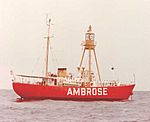 |
|
| Lettie G. Howard | 1893 | Schooner | This fishing schooner was launched in Essex, Massachusetts. The ship is 125 feet long and 21 feet wide. It was mainly used for fishing near the coast of Yucatan. In 1989, it also became a National Historic Landmark. | 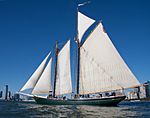 |
|
| Pioneer | 1885 | Schooner | This schooner was launched in Marcus Hook, Pennsylvania. It was first a sloop, but in 1895, it was changed to a schooner. The ship is 102 feet long. Its hull was originally wrought iron but was rebuilt with steel in the 1960s. It carried goods like sand, wood, and bricks. Now, it offers educational tours of New York Harbor. | 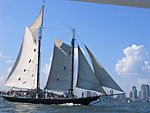 |
|
| W. O. Decker | 1930 | Tugboat | This 52-foot steam tug was built in Long Island City, Queens. It was first named Russell I. Later, its engine was replaced with a 175 horsepower diesel engine. In 1986, the boat was given to the South Street Seaport museum. In 1996, it was added to the National Register of Historic Places. | 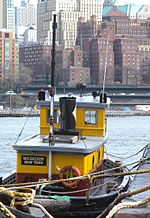 |
|
| Wavertree | 1885 | Freighter | This ship was launched in Southampton. It is 325 feet long including its spars. The ship is the largest remaining wrought iron vessel. It first carried jute from India to Scotland. Then it traveled around the world carrying different goods. In 1947, it became a sand barge. In 1968, the South Street Seaport Museum bought it. In 1978, it was added to the National Register of Historic Places. | 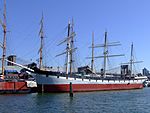 |
Legend:
- – A National Historic Landmark and on the National Register of Historic Places
- – On the National Register of Historic Places
The Pioneer and W. O. Decker offer trips when the weather is good.
The museum also had the ship Peking from 1974 until 2016. It was then given to the German Port Museum in Hamburg, Germany.
Streets and Places to See
Since 1972, most vehicles are not allowed on six blocks within the Seaport. Only emergency vehicles can drive there.
Peck Slip
Peck Slip is an area between Water and South streets. It was a busy docking place for boats until 1810. In April 1776, George Washington and his troops even used it as a temporary hiding spot. In 1838, the first steamship to cross the Atlantic, the S.S. Great Western, docked here.
Today, the middle of Peck Slip is an open space for the community. It has great views of the Brooklyn Bridge. You can often see public art, fairs, and concerts here. Peck Slip is also home to The Peck Slip School, P.S. 343, which is an elementary school.
Pier 17
Pier 17 was rebuilt in the 2010s and reopened in July 2018. The new Pier 17 was designed by SHoP Architects. It has about 212,000 to 300,000 square feet spread across four stories.
ESPN opened a radio and TV studio at Pier 17 in April 2018. Pier 17 also has different restaurants on its lower floors. These restaurants have large glass walls that can close during bad weather. On the roof is The Rooftop at Pier 17. This is a large outdoor concert venue that can hold 3,500 people. It hosts summer concerts from May to October. The rooftop space is open all year and has a big art piece designed by Achim Menges.
Other Interesting Spots
Decks on Pier 15 offer views of the East River, Brooklyn Bridge, and Brooklyn Heights. The Paris Cafe, in the historic Seaport area, is said to be one of the oldest bars in New York City.
The Fulton Building has the iPic theater. It has eight movie rooms, each with 43 to 143 seats. Some seats are special two-person pod seats.
At the entrance to the Seaport, you can find the Titanic Memorial lighthouse.
Getting Around the Seaport
The South Street Seaport is served by the M15, M15 SBS New York City Bus routes.
A regular ferry, the Fulton Ferry, used to run between Pier 16 and Brooklyn until 1924. Today, New York Water Taxi serves the South Street Seaport on Fridays, weekends, and holidays in the summer. Other ferries like New York Water Taxi, NYC Ferry, and SeaStreak serve the nearby ferry slip at Pier 11/Wall Street every day.
The Fulton Street/Fulton Center station complex (2, 3, 4, 5, A C E, J, N, R, W, and Z train) is the closest New York City Subway station.
Images for kids
See also
 In Spanish: South Street Seaport para niños
In Spanish: South Street Seaport para niños



